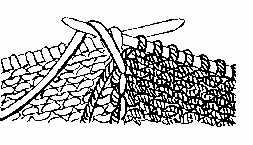Advanced Knitting
Last Updated: 08/05by University of Kentucky 4-H Youth Development
![]()
This resource, Advanced Knitting CT-MMB.732, is available from University of Kentucky 4-H Youth Development, and used here with permission.
Advanced Knitting
Advanced knitting builds on the stitches, patterns, and techniques learned in the beginner and intermediate sections. Not only will new patterns be introduced, but the knitter will be encouraged to design or change some patterns. Be alert to patterns in magazines, knitting books, or online, and search the Internet to find patterns you might like to use. Remember that good instructions include:
- A list of materials required
- A gauge for number of stitches per inch and number of rows per inch
- Print large enough to read easily
- A clear photograph of the finished garment so the details can be seen
- Detailed instructions for finishing the item
- A chart with the size range for the knitted garment in relation to body measurements.
Plan Your Project
When shopping for yarn, remember to purchase all of the yarn you will need to complete your article, because colors vary between dye lots. It is much better to have a little yarn left over than to run out in the middle of the project.
KNITTING TOOLS
Check your tools before you start. Many of the same tools will be needed at this level as in previous level(s). In addition, you may need bobbins if choosing a project that includes intarsia or bobbin knitting. Bobbins hold individual colors of yarn that are only needed in small areas of your design.
ADVANCED KNITTING TERMS
Often times you will find that the same stitch patterns will have different names/ abbreviations. Good directions will explain the abbreviations being used. Below are examples of three different names/ abbreviations that all create the same stitch.
Back cross (BC), Twist Back (TB), & Left Twist (LT):
[uses 2 sts] slip 1 stitch onto cable needle to back of work, knit 1 stitch, then knit stitch from cable needle.
This stitch may also be accomplished without the use of a cable needle by working behind the first stitch on the left needle, knit into the back of the second stitch, being careful not to drop stitches off the left needle. Knit the first stitch, and then let both stitches drop off the left needle.
Front cross (FC), Twist Front (TW), & Right Twist (RT):
[uses 2 sts] slip 1 stitch onto cable needle to front of work, knit 1 stitch, the knit stitch from cable needle.
This stitch may also be accomplished without the use of a cable needle--knit 2 together but don’t drop stitches off the left needle. Knit the first stitch, and then let both stitches drop off the left needle.
Cable Back (CB):
Cable stitch in which stitches on the cable needle are held in back of work. This creates a right twisting cable, and may also be written as (C4B), which means the cable stitch is made over four stitches, 2 being held on cable needle while the next 2 stitches are knit.
Cable Front (CF):
Cable stitch in which stitches on cable needle are held in front of work. This creates a left twisting cable, and may also be written as (C4F) which means the cable stitch is made over 4 stitches, 2 being held on cable needle while the next two stitches are knit.
KNITTING WITH A COMBINATION OF COLORS
Knitted items made with a combination of multiple colors have many different names or titles, such as Fair Isle, Scandinavian, Norwegian, and Argyle.
Argyle is the term used for articles made with a diamond-shaped pattern of two or more colors. It is best to use bobbins when knitting an Argyle pattern.
Fair Isle is the term given to the type of knitting where a pattern or design is knitted into a garment using two or more colors. It can be an all-over pattern or a partial pattern, such as a yoke of a sweater or the cuffs of mittens or socks. It is easier to knit a Fair Isle pattern by following a graph than by working from ordinary directions. A Fair Isle pattern may be worked by carrying the colors not in use across the back, or wrong side, of the work, or it may be worked by using bobbins. Scandinavian and Norwegian knitting are basically the same as Fair Isle. Their names are derived from the region in which this type of knitting is characteristic.
Following a Graph
You will find various symbols used by different pattern books to identify the colors when several colors are used to form a design.
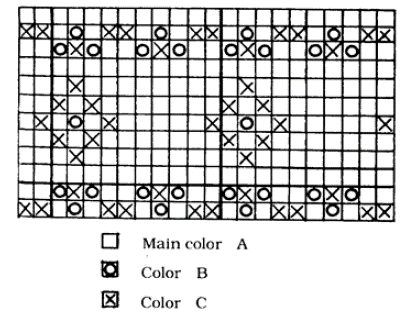
Remember: When following a graph, use the colors called for, or substitute colors of your choice.
Changing Colors
When knitting with two or more colors, whether it is Fair Isle or bobbin work, the yarns should be twisted at the back of the work when changing from one color to another to avoid holes in the work. After knitting the required number of stitches of one color, lay the yarn you have been using along the left-hand needle at the back of the work, pick up the new color from underneath, and knit the required number of stitches. This will twist the two colors and prevent holes. On each color change, place the yarn just used on the left-hand side in the same manner before working with the new color. This is also referred to as intarsia knitting.
FAIR ISLE KNITTING
Fair Isle is when colors change back and forth every few stitches. The color not being used may be carried across the back of the work in two ways.
First: When the spaces between are not more than three stitches wide, the yarn not in use is carried across the back of the work. Be careful to carry the yarn loosely enough to match the elasticity of the knitting itself. Remember when you are changing color to pick up the new yarn from underneath, as described above. It may be easier if you carry the yarn not in use in your left hand and the one being used in your right hand in the usual manner.
Second: When the distance between two colors is more than three stitches, the color not in use may be woven into the back or wrong side of the article while knitting. This prevents loops on the wrong side. This procedure is done by holding the yarn being used in the right hand in the usual manner; the yarn being carried is held in the left hand and carried on the wrong side of the work. Knit one stitch in the usual way, insert the needle into the next stitch, but before catching yarn to knit, place the yarn you are carrying over the needle. Now work stitch in usual way, slipping off carried yarn as the stitch is completed. Continue working in this manner, catching carried yarn in every other stitch. Be careful not to draw up carried yarn too tightly.
If the pattern falls so that each color appears in more or less definite blocks or spaces, it is best to attach a new ball or bobbin of yarn where each change of color occurs. To do this, follow the direction for bobbin knitting.
BOBBIN KNITTING
When working a pattern where colors appear in a definite block or line (such as Argyle), it is best to use a separate bobbin of yarn for each change of color. In a pattern of this type, the directions usually tell how many bobbins to use and how much yarn to wind on each one. When changing colors, twist yarn by bringing new color under yarn you have been using as you do when working with Fair Isle knitting.
If, except for the bobbin you are knitting with, the bobbins are rolled tightly, it will prevent them from becoming tangled.
Break off colors when they are not needed in the design, leaving 5-inch ends to weave in later.
ARAN ISLE KNITTING
The Aran Islands at the entrance to Ireland’s Galway Bay have given their name to the knitting done by their inhabitants. Usually worked in unbleached wool, the knitting is characterized by raised pattern stitches set side by side. An Aran Island article would include several pattern stitches, such as cables, rope cables, raised diamonds, and seed stitches.
Sweaters knit in the Aran Islands are highly prized by ski enthusiasts and fishermen. Some of the woolen yarns used for these sweaters are spun with a certain amount of grease or lanolin left in them so they shed water.
Aran yarns are available at yarn shops. The yarns are heavier and bulkier than 4-ply knitting worsted. Synthetic yarns are available which resemble the unbleached woolen yarns used in the traditional sweaters.
KNITTING WITH MULTIPLE PATTERN STITCHES
Choose pattern stitches very carefully. Whether you are going to make a sweater, shawl, coat or socks, there are several groups of stitches suitable for each item. Not all stitch groups are suitable for every article. It is important to choose the pattern stitches to suit the article to be made.
Look carefully at the illustrations and photographs of knitted articles in knitting books. You may not care for the particular stitch proposed by the designer. You may prefer to substitute another pattern stitch.
Substituting Pattern Stitches
The first thing must be to observe the stitch gauge in the original directions, then make a swatch of the stitch you prefer. If the swatch gauge compares exactly with the measurements given in the instructions or if it can be made to compare using another size needle, it is reasonably safe to substitute the preferred pattern stitch and follow the directions given.
Never substitute any pattern stitch without first making a sample swatch. Always work a piece at least 4 inches square with the exact yarn and needles to be used for the article. Yarn of another color may even vary just enough to produce variation in gauge.
Next, look at the new pattern stitch to determine if it is a “multiple.” For instance, the original pattern might require a multiple of 8 stitches but the desired pattern stitch might require a multiple of 6 stitches. Assume the instructions call for a total of 128 cast on stitches. This number divided by 8 (the multiple of the original pattern) is 16 – meaning there are 16 pattern repeats of that stitch. The number 128 divided by 6 is 21, with 2 left over. Therefore, switching from the original pattern stitch to the desired pattern stitch would require an adjustment in the total number of stitches to be cast on. The original number (128) should be changed to 126 to allow for the extra stitches required in the original pattern. The difference, plus or minus, of 1 or 2 stitches between the two stitch patterns is easily absorbed and should not affect the fit too drastically.
If the instructions do not give the multiple of the stitches in the directions, it is not difficult to find the multiple. Look for the two asterisks (**). One of them will be at or near the beginning of the numbers in the row, and one near the end. To find the multiple, count from the first * to the second*. Cast on at least twice that number of stitches and work the pattern into a sample swatch.
When two or more pattern stitches are to be used in the same article, the stitch gauge of each of them must be determined before changing from one to the other. It is possible that the gauges are different and stitches may have to be added or taken away in the first row of the new pattern stitch. If the gauge of the second pattern stitch is not the same, either change the size of the needle or take out or add the difference in each inch of the number of stitches that the new pattern stitches require.
Give the patterns a chance. Try to ignore the complexity of a pattern stitch as written. Many of the pattern stitches may appear to be too complicated to tackle, but once a swatch has been made and two or three repeats completed, the pattern will come to life. It can be fun to work pattern stitches out and an exciting challenge to see the outcome of your efforts.
Hundreds of pattern stitches are available in knitting resources. The choice is yours!
ADVANCED TECHNIQUES
Making Buttonholes for Cardigans
Buttonholes are made on the left band for boys/men, and on the right band for girls/women.
To make a buttonhole, knit to the position for a buttonhole as specified in the directions. Bind off three (or the number called for) stitches and knit to the end of the row. Work the next row in the pattern as far as the bound-off stitches. Turn your work and cast on as many stitches as were bound off in the previous row.
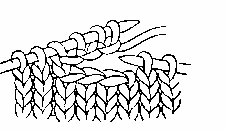
Complete the row. The finished buttonhole should look like the one below.
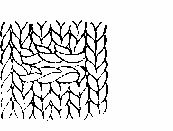
The knitted buttonholes should be backed with preshrunk grosgrain ribbon. Using a sewing needle and thread that matches the color of your yarn, slip-stitch the ribbon to the center front openings. Turn under the raw edges of the ribbon at the neck and bottom edges. Slip-stitch these edges, also.
Work the buttonholes through the knitted buttonhole and grosgrain ribbon with the buttonhole stitch. Use matching yarn or thread. Be careful not to pull the stitches too tightly.
Buttons
Select buttons or make buttons to complete the sweater. The pattern will recommend the correct size for the sweater. Be sure to purchase a button with a shank.
Sewing On Buttons
When sewing buttons on the sweater, plan on using an additional thread shank. The additional shank allows the button to rest on top of the buttonhole instead of crowding it to the inside and distorting the buttonhole. One way to sew a thread shank is illustrated below.
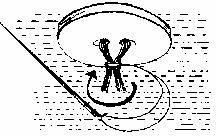
To make a thread shank, secure the thread at the button mark. Bring the needle up through one hole in the button. Lay a pin, toothpick, or matchstick across the top of the button (between the button and the thread).
Sew through the holes in the button several times. Remove the pin or stick and lift the button away from the sweater so the stitches are tight. Wind thread firmly around the stitches to make the shank. Backstitch into the shank to secure it.
Knitted-in Hem
This hem is sometimes called a “picot hem” or hem with “treasure teeth.” As the turn row is knitted with eyelets, it gives a dainty, decorative finish to any garment. It is especially nice for the bottom hem or cuffs of a plain jacket or sweater.
Cast on the required number of stitches, using the “knit-on” or single thread method of casting on. Work to the desired depth of hem (ending with a purl row), knit a row of eyelets for the turn row: k 1, * yo (yarn over), k 2 tog. Repeat from * across row, ending with k 1 (always knit the first and last st of row). On the next row, purl the yarn over as an ordinary stitch. Work the same number of rows as before turn row, again ending with a purl row. With another needle, pick up the loose stitches on the cast-on edge (the number should equal those on the other needle). Fold up on turn row, with wrong sides together. Bring both needles together and with a third needle, knit the two together, taking one stitch from the front needle and one from the back needle, and knitting them both off as one stitch. This will form a hem with a picot edge.
Grafting
When joining two bound-off edges together, such as the shoulders of a sweater, you can use grafting to produce a neater seam than that made by sewing or crocheting. When grafting the shoulders of a garment, it is best to start at the armhole or sleeve edge and work towards the neckline.
Thread a yarn needle with the same yarn used to knit the garment. Place the two edges together with the right side facing you. Look carefully at the two pieces, and note that the stitches on the piece farthest away are going away from you, and on the piece nearer you, the stitches are coming toward you. Secure the yarn at the edge of the work and insert the needle under the first stitch coming toward you on the near side, just inside the bound-off edge. Insert the needle horizontally. Draw the needle through and insert it under the matching stitch going away from you on the far side. Draw the needle through. On succeeding stitches, insert the needle into the same point where the yarn came out the stitch before.
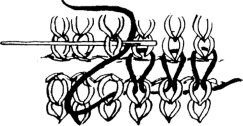
Grafting is always done from right to left, and the needle is always inserted under the stitches horizontally. It makes a smooth, flat seam. If the tension is even, it is very neat.
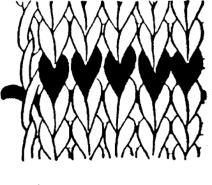
KNITTED LACE
Knitting can be used to make beautiful lace patterns and object. Delicate holes are formed through a combination of “yarn over” stitches and subsequent patterned decreases. “Lace knitting” incorporates lacy stitches in which the “hole” rows alternate with a plain knit or purl row. “Knitted lace” is an object worked entirely in lace techniques, often the holes being in every row. As with other sorts of knitting the patterns can be worked with a variety of yarn/thread and needle sizes.
Crochet cotton is often used to create knitted lace. Very fine needles come in sizes that can go down to 1.5mm (U.S.000) for straight needles and double pointed sets can be found down to 000000 (0.75mm).
Most knitting reference books contain patterns for lace knitting. Specialty publications may provide lace instructions in the form of graphs, where different pattern stitches are represented as symbols. Standard symbols are: (0) for yo, (/) for k2tog and (\) for ssk.
Plain squares are usually knitted on the right side and purled on the wrong. Odd- numbered rows are read from right to left; if there are no even rows on the chart, they are to be purled. For example, the row k3, yo, k2tog, k5, ssk, yo,k2 would be charted as follows:
| 0 | \ | / | 0 |
A great way to start out knitting lace is to knit a washcloth or bookmark. Pick a pattern and enclose it in a garter stitch square. Wash clothes should be knit using 100% cotton worsted weight yarn; size 7 or 8 needles. Use #10 cotton crochet yarn and size 2 needles for knitting a lace bookmark.
Careful blocking will enhance the look of the completed lace. An easy way to do this is to lay down a towel on your carpet, dampen the lace item and pin it out (use rustproof pins), stretching it as much as you can. Unpin when completely dry. You may want to stiffen the bookmark by starching or dip in a mixture of equal parts water and white glue before blocking. Allow it to dry.
Simple Lace Stitch (multiple of 6 plus 1)
Row 1 and 3: k all sts
Row 2: p all sts
Row 4: k1, *yo, k 1, sl 1, k 2 tog, psso, k 1, yo, k 1 – rep from *, ending with k1.
Row 5: p all sts
Row 6: same as row 4
Row 7: p all sts
Row 8: same as row 4
For an elaborate-looking stitch, this is very easily worked. It is appropriate for shawls, stoles, and baby garments. It is particularly effective when worked with very fine yarns on a #4 or larger needle. Just one repeat of the pattern makes a lovely scalloped edging for collar and cuffs.
A variation of this stitch that will give a stockinette background to the lace: Follow the above directions but insert an additional row of purl st after row 3.
KNITTING WITH BEADS
Beads can be used to embellish knitted items. To knit the beads into your work, you must first thread beads on to your yarn. This is done with the use of a threading needle that will both accommodate your yarn as well as go through the hole of the bead. A dental floss threader is an inexpensive alternative to a beading needle.
Be sure to purchase more beads than you need as some beads will have holes too small to be threaded. Take into consideration the compatibility of your bead and your yarn as far as washing or dry cleaning is concerned.
Once threaded, push the beads down on the yarn until they are needed. It may help prevent them from tangling by putting the beaded yarn in a plastic bag.
When knitting, the bead will lie over a stitch. If working a stockinette stitch pattern, a slip stitch is used when adding beads. The bead falls directly in front of the slip stitch. To do this, work to the stitch before the placement of the bead. Bring the yarn to the front of the work and slide a bead up to the needle, slip the next stitch as if to purl. Take the yarn to the back of the work, keeping the bead in the front on top of the stitch that was slipped.
Continue to work the rest of the row, adding beads in the same manner where indicated. If beads need to be added when you are working on a wrong side row, the process for adding the bead is reversed. Purl up to the point where bead is to be added, take yarn to the back, slide bead up to knitting, slip the next stitch as if to knit, bring yarn back to front, and continue to purl until next bead is added.
When working a garter stitch pattern, the beads are added while working on a wrong side row, allowing the beads to fall between the stitches on the right side of the work. To add beads, work to where the bead is to be added, with the yarn in back, slide the bead close to the needle, then knit the next stitch. Do not move beads when working right side rows.
DESIGN YOUR OWN PROJECT
Now that you are comfortable with knitting, why not design your own project? You can with the help of a few calculations. First you need to select your yarn. Using the suggested needle size from the yarn label, knit a swatch to determine your gauge. If you have selected a pattern stitch, be sure to knit it into a gauge swatch. Different pattern stitches, even if they have the same multiple, will often knit to different gauges. Your gauge swatch should measure at least 4 inches square. Once you have determined the number of stitches per inch, and number of rows per inch you are ready to calculate how many stitches are needed to cast on.
Use this formula:
You may want to create a border stitch to "frame" your work. To do this, determine the number of stitches you want for the side border. Multiply by two and subtract this number from your total amount. The remaining number of stitches is what is available for your pattern stitches. Divide this number by the number of stitches required for one pattern repeat (pattern multiple). If this number isn't a whole number, you will have to adjust by adding or subtracting stitches so that you will end up with complete patterns across your work.
For example:
Your gauge figures to be
The pattern stitch requires a multiple of
15 plus 1
To make an afghan that measures
Each border requires 5 sts
You have 4 extra stitches, you can drop those from your total to cast on or add 11 to the total to make another complete pattern. Therefore you will need to cast on either 221 stitches or 236 stitches. Do you want your afghan to be a little smaller or a little bigger? You decide—after all, you are the designer!
To determine how many rows you will have to knit, use this formula:
Once again you need to consider the number of rows for your border and how many rows a complete pattern requires. In this case the pattern requires 10 rows to complete.
60" x 6.5 rows = 390 rows
Border requires 2 rows each
In this case you need to add 4 rows to complete the last pattern rows. You will have 39 repeats of the pattern the length of your afghan.
Be creative by combining different pattern stitches together in your design. Remember that if you do your own design, document it by recording your calculations and any drawings you used to create it.
This publication is based on Knitting with a Combination of Colors, Knitting with One or More Pattern Stitches, Aran Isle Knitting, and Knitting with Four Needles written by JoAnn Hilliker, State Extension Specialist in Clothing and Textiles, Kentucky Cooperative Extension, 1980. Many of the illustrations in these publications were courtesy of the Educational Bureau, Coats and Clark, Inc.
Educational programs of the Kentucky Cooperative Extension serve all people regardless of race, color, age, sex, religion, disability, or national origin.


